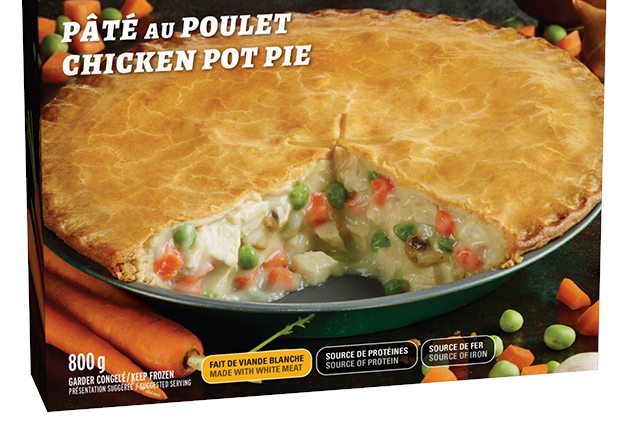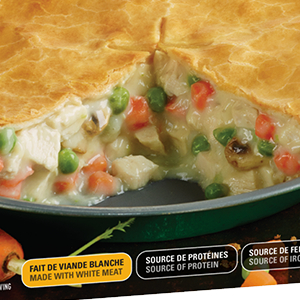Just a quick note this morning to report my experiences with 3 different frozen meat pies, all sold under different labels and – one assumes – by different makers. Read on to find out which of the Chicken Pot Pies we tested passed the taste-smell-texture-bite-whatever tests…
 With the resto-brand frozen pie, you.re much more likely
With the resto-brand frozen pie, you.re much more likely
to get what they show on the package!
What a disappointment, to find that two of the biggest brands on the market failed the real-life test with their highly-touted frozen Chicken Pot Pies! If I had not been in on the tests myself, as a first-person participant, I might not have believed the results. But I was. And I wrote the results.
The contenders
One of the Pies, which we’ll call Pie 1, was a premium-priced offering by a company that operates a nation-wide chain of specialized frozen food retail stores. They started out several decades ago by offering premium-quality flash-frozen vacuum-packaged meats at great prices and gradually branched out into all niches of frozen foods. Now, they publish a weekly flyer running an average of 4-to-8 tabloid newspaper pages in full colour, hawking their specials – from ready-made Meatballs to Filet Mignon. They also offer a full range of ready-made frozen entrées and sides. Hundreds of products, in total. One assumes they don’t make their own products any more; just contract with folks who do have the facilities and expertise to make things like frozen Chicken Pot Pies in runs of tens of thousands and pack them for shipping across a continent.
That final comment, on third-party ghost manufacturers, surely applies also to Pie 2, which is offered under the otherwise prestigious house brand name of one of Canada’s largest supermarket chains. More on that assessment to follow. This chain started by offering what they called (not the actual brand name they use) ‘The Boss’s Choice’ cooking sauces from around the world. These were followed by other products designed to offer customers a prestige house brand alternative to the big brands. The idea was, customers were supposed to think that ‘The Boss’s Choice’ – sold at about the same price and sometimes higher than the regular brands – was either higher-quality or somehow ‘better’.
Pie 3 is the only one not offered by a big food retail chain. In fact, it’s the extension into the retail universe of a highly-successful, almost-legendary Rotisserie Chicken restaurant chain that operates in central Canada (mainly in Ontario and Quebec). Responding to calls from its customers for ‘take-home’ versions of its resto menu favourites (see photos, above, top of page), they came up with a limited line of frozen selections which would have been hard if not impossible to deliver to fans by the usual-‘take-out’ procedure.
The contrast between Pie 3 and Pies 1 and 2 was like night and day.
Crust
One of my biggest beefs. I think we all know – or should know by now – that pastry needs for main ingredients for success: flour, fat, water and salt. The crusts on Pie 1 and 2 were horrible concoctions that seemed to have been composed of water and flour, with precious Salt and maybe no fat at all. That’s just a subjective assessment, not a lab analysis. But, hey, how else would one judge the appeal of a food product?
The crusts on Pies 1 and 2 can be judged together. My suspicion was that both pies had been produced by the same third-party manufacturer, to the custom packaging specifications of the two different retailers, but otherwise could have been identical. The other major complaint I had about the crust on Pies 1 and 2 was their thickness. I learned many years ago that the ideal thickness for pie crust was 1/8 in. – 3 mm to 3/16 in. – 5 mm. The crusts on the first 2 pies were at minimum 1/2 in. – 12 mm thick. And the inside surface of the bottom and side crusts was heavily ‘gummed’. That is, it was soaked with sauce from the ‘filling’ and tasted/chewed like gummy, flavourless mush. The top crusts were similar in thickness but did not suffer s much as the bottom and sides from the ‘gumminess’ scourge. Nevertheless. I only tried one bite of the top crust – having already passed on the lower crusts – before giving up all together. Even the non-gummy portion of the upper crust tasted like compressed flour with no salt or fat, and crumbled into powder when I tried to chew it.
The crust on Pie 3 was really good, by comparison. I was pleased to find it was thin and crispy and nicely browned on all sides, and tasted as if it had a reasonable amount of fat and salt in it. Thank you very much. Even my picky, elderly mother proclaimed Pie 3 to be one of the best ‘bought in’ menu items we’ve tried yet. And that that estimate went for the filing, too (see below).
Filling
I know it costs a lot, relatively speaking, to go generous with the filling for something like a Pot Pie these days. You’ve got chicken, veggies and so on to pay for. But I was shocked to discover that Pies 1 and 2 contained only a few (6-8) pieces of diced chicken, and maybe 10 pieces of diced carrot and 8-10 green peas. The rest was something that – I presumed – was supposed to be a simple sauce made of chicken broth, flour or some other neutral thickener, and flavourings. I detected something that could have been onion powder. It was simply awful; tasted pasty and bland.
Pie 3, however, was very similar to the product I had previously consumed at the brand-owners restaurant. Lots of veggies, and a piece of diced chicken in every bite. The ‘sauce’ was lighter and creamier than that offered in the other ‘Pies’, and quite tasty by comparison.
Size and weight
Pies 1 and 2 were about the same size and weight and – allowing for the thickness of the crusts – contained about half the filling, by the thickness of that layer, that Pie 3 offered. Now, that’s a feature that represents a major value advantage for Pie 3. Pie 3 was about the same overall thickness – 1 1/4 in. – 3 cm – but, as a result, had a much better filling-to-crust ratio by volume, by virtue of its thinner crust.
My overall take
Seems to boil down to this: If, when marketing a take-home frozen version of a house brand, better go with a product that the brand has a stake in; i.e. – the known quality of the product as consumed in the restos of Pie 3‘s maker – to protect, and won’t go cheap like the purveyors of Pies 1 and 2, which had nothing for customers to compare with. Also, pay a dollar or two more for the familiar brand name. The difference between the $9.99 (‘on sale!’) house brand pies and the $11.99 resto-brand pie was, as I’ve said, like night and day.
Did I mention that Pies 1 and 2 weren’t really large enough to feed a family of four – even aside from their quality failings – but Pie 3 was?
In short, Pie 3 was well worth the extra money. Pies 1 and 2 definitely were not. Even ‘on sale!’
~ Maggie J.

